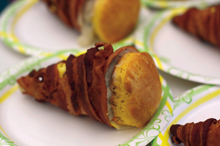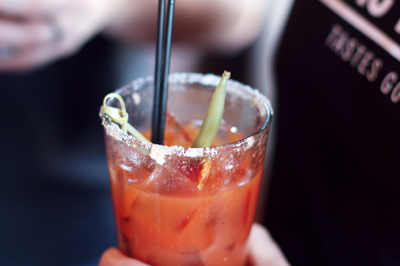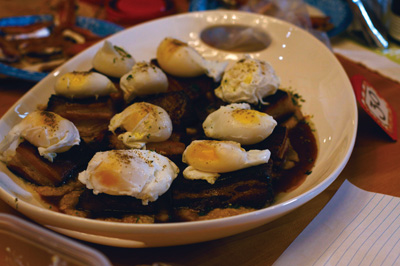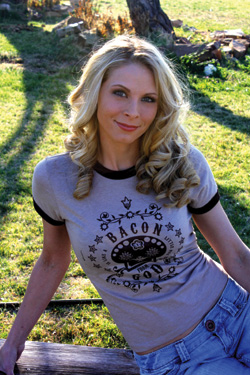Chapter 5. Launching with a Live Audience
AS ALREADY MENTIONED, we were planning on launching the site at our first annual bacon party. Great idea, right? Lots of bacon fans would come; we would be the hosts; bacon would be the guest of honor … a perfect time to announce and launch our new bacon venture.
The problem was, throwing a party for nearly 100 people is a large undertaking. And we were trying to launch a website. And the date for both was only three weeks away. And there were only three of us. And none of us had ever thrown a party like this before.
This meant that there would be a lot to do right after we launched, because we weren’t going to be able to take care of everything beforehand. It also meant we better get started on that party.
The Epic Event
When deciding what to call the event, we tapped our friends for help. We wanted it to be fun and light-hearted, but of course it also had to be rooted in bacon. Scott sent out a Twitter message asking his followers what we should call it. Within an hour or so, Kelly Guimont (@verso on Twitter) responded with “MasterBacon.”
When it comes right down to it, the three of us are still little boys who giggle at penis jokes. So we laughed—out loud—and agreed it was a great name. It’s not the classiest brand in the world, but it was perfect for the casual nature of the party. And seriously, MasterBacon? That’s funny.
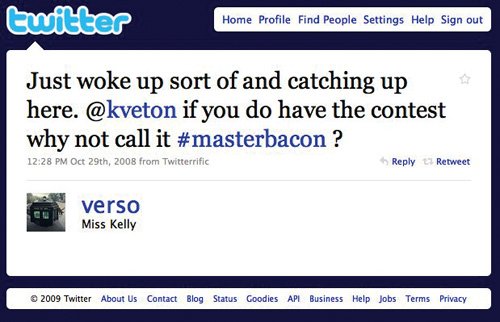
The Twitter message that named our event
Location, Location, Location
The biggest problem in holding a bacon event was finding a location that would let us use their space. We didn’t have a budget for renting a venue, and with our guest list growing by the day we knew were going to need somewhere fairly big. We were hoping to find a restaurant or lounge that would partner with us; however, many were sticklers about some law preventing other people from bringing food into a restaurant or uncooked pork and health codes or blah blah blah. Thus, the first handful of locations we called all declined our offer. Awesome.
But despite the first few places turning us down, or health laws working against us, we didn’t lose heart. The economy was in the toilet and restaurants were hurting. We knew if we were patient, we’d find a place.
While we were hunting for a location, our vision for the event matured. It changed from the idea of a simple party where Scott would cook a bunch of bacon and bacony recipes and turned into more of an unconference or “camp.” This type of event became popular with the inception of BarCamp in 2005, and seemed perfect with its inclusive, participatory nature. So we began shifting the focus from an invitation to come to an invitation to participate. We started asking everyone to bring bacon-themed recipes, which of course led to the idea of a competition.
Finally we got in touch with the Davis Street Tavern. It’s an upscale restaurant in Northwest Portland, and the owners immediately understood the possibilities with our party. They not only agreed to let us host the event there, but right away started figuring out ways they could participate as well.
As we worked with them, they made plans to have three bacon-themed cocktails for the event. The first drink was a bacon Bloody Mary called Porky’s Revenge. The glass was rimmed with BaconSalt, then filled with bacon-infused vodka and Bloody Mary mix before finally being garnished with an olive and a small slice of thick bacon. It was amazing. They had two more equally relevant drinks: a Bacon Old Fashioned and one called the 7th Degree of Kevin Bacon. Their menu also featured pork-belly specials to round out the offering.
While pig parts are not a common beverage condiment, the Porky’s Revenge with bacon was amazing. Don’t worry, the green bean is just garnish—you don’t have to eat that.
The Davis Street Tavern went above and beyond what we expected from them. They actually got excited, participated, and improved upon what we were doing. As we’ve learned, venue enthusiasm is critical to throwing a good event. If the best you can do is get a venue to allow you in their doors, your event won’t be nearly as impressive as it will be if you find a place that will really partner with you and expand on your ideas.
The Big Day
When the day of the event came, we welcomed 32 entries into the bacon-dish competition and nearly 100 attendees. We even saw a few guys with bacon tattoos at the event, and several people we had never met came in from out of town just to take part in a bacon party. Much like our personal research earlier, it proved that people love bacon. We even had a vegan there, willing to try some bacon “just this once.”
Poached eggs on pork belly … a chef’s contribution
For the competition we had several local “internet” celebrities in to help judge the recipes. This was great, because many of them tweeted about the party and our sphere of influence grew to a much larger crowd than we could have drummed up on our own.
One thing the judges didn’t count on was that after trying 32 different types of bacon dishes, they would be a little full, if not a bit woozy. Yet everyone powered through, and then washed it all down with drinks made with bacon. (We heard from a few later on that it took them a few weeks to want to have bacon again. So now we know that there is such a thing as bacon overload.)
Some of the tasty foods that people brought
At the end of the night we gave away a few awards to winners of different categories—bacon-themed prizes, of course. A few dozen pounds of bacon itself went home with the winners, along with some T-shirts and some bacon cooking supplies. It turned out to be a great way to promote and announce our launch.
Even though the event wasn’t about our company, everyone noticed that we were launching something. And if there was anyone who didn’t know about Bac’n at the beginning of the day, there was nobody at the end of it. We had great tweets about Bac’n, and the party and the launch were written up in the local newspaper. Not bad for an event that only cost us some sample merchandise and a few T-shirts (and a few years off of our lives).
Going Live
On the day of the party, January 17th, we announced Bac’n, and made the Bac’n site live. It was an eleventh-hour effort to get everything in place, but the morning of MasterBacon we turned on the site and began accepting orders. Midway through the event, we actually got our first order. Admittedly, it was Scott’s dad who ordered the first package, but still it was so good to know that everything was functioning correctly and the orders were being properly placed and tracked.
By the end of the following night, as we said goodbye to a weekend of MasterBacon and crossing our fingers that we hadn’t forgotten anything major, we already had several orders. Plus, we were starting to get orders from outside the circle of our friends and family. The first order from a person we’d never met was a big milestone for us.
Getting Eyeballs and Paying for Traffic
Obviously MasterBacon was not only a good time, but a chance to get some coverage for our launch. We were written up in the newspaper, and loads of tweets and blog posts were written about the event. Most of that coverage mentioned the new site, and those links were super valuable.
Even with the traffic coming from that media coverage, we knew we still had a long way to go. Most of the traffic would quickly die if we didn’t continue to get other people talking about Bac’n. And we needed to get them talking about the site itself, not the party.
We sent emails and messages to most of the people we knew who had any sort of online presence and asked them to cover what we were doing. We talked about how we launched in three weeks, how our bacon was amazing, how the three of us were doing this as a side-project. In short, we talked about anything that could provide an angle, and anything that would result in blog posts, links, or general buzz.
When you’re starting a brand new site, it’s very hard to get organic traffic, because the search engines don’t know anything about you. You have very few links pointing to you, and your site is new, and thus perceived as less trustworthy by Google. In the early stages, if you want real traffic you’ll have to pay for it, either by doing something awesome, by buying advertisements, or both.
Pay-Per-Click
We set up a Google Adwords campaign with very specific keywords. You don’t want to pay for terms as generic as “bacon,” because with something that broad it’s very hard to determine intent. Some people will search for bacon so they can find a photo of it, some will be looking for Kevin Bacon’s most recent movie, others may just be seeing what comes up when you search for “bacon.” The more specific your keywords are, the more you can tailor the results and imply intent. So we focused on things like “pepper bacon,” “uncured bacon,” “nitrate-free bacon,” and used those ads to send people directly to the product area of the related bacons. When people are looking for a specific product, especially something as specific as “Fletcher’s Pepper Bacon Slab Pack,” the chance that they are looking specifically to buy goes way up. That’s why we tried to use those keywords as often as possible.
 Note
Note
The more specific and detailed keywords are considered “long tail” keywords as an illustration of the normal distribution curve and how it has elongated along with the rise of the Internet. The term was coined by Chris Anderson in a 2005 Wired magazine article.
The problem with this approach, however, is that you might have a huge list of keywords with different ads. And managing all of the ads can be very cumbersome. You can put the keywords into large groups (so you’re managing ads and keywords in a bundle), but then your keyword bids are averaged and may have you paying more per click on a specific keyword than you would if they were bundled in smaller groups.
Another issue is that as competition comes and goes, your own ads are affected. If a competitor creates new ads focusing on the same keywords as yours, your price either goes up, or your position falls. Pay-per-click ads are never a “set and forget” type of business.
 Note
Note
Be careful when you get started with pay-per-click ads. It’s easy to spend a lot of money really fast trying to get traffic, only to realize later that all your profits are lost getting people to order, and you’re not making any money for your work.
But don’t be afraid to experiment. We had decent results when we kept our daily limits low and kept a close eye on a small group of keywords. We focused on what set us apart, and what seemed to have the best traffic for the lowest cost. We then compared that to our site conversions, and went back and adjusted. We never spent a lot of money on ads, but it was a good way to spread the word early on, and we had acceptable results for our money.
We also tried some Facebook ads (which can be very cheap), but in our experience they didn’t generate enough traffic. This was in 2009, so by the time you read this, Facebook may have changed. They have so much traffic that you should always give them a shot, but don’t be afraid to pull the plug and focus on more effective methods if you’re not seeing the results you need.
Filling Up on Content
Another part of launching was adding content. In the process of getting and testing different bacon, we got plenty of photos and video of our food products, but we were still missing photos of our T-shirts. We also wanted to get some more content for our blogs. Content for blogs is important because it’s a great way to improve search results for a variety of long-tail phrases, and it allows you to link to other people—which hopefully gets them to link back to you.
The Photo Shoot
On launch day we had only some simple photographs of our shirts. They showed shirts lying flat on a table—not the most stunning photos, but they showed the products reasonably well. We knew that photos of people wearing the shirts would be much better, though, and shortly after launch we scheduled a photo shoot.
We waited until we had all of our shirts in stock, in all styles and colors, and then we sent out an invite on Twitter to see if anyone would be willing to come and take part in the shoot.
While it would have been great to have a pro help us out, you do what you can with what you have, and that’s what we did. We both had pretty nice cameras, and were reasonably adept at using them. Neither of us had formal training, but it’s much easier to be a good photographer in the digital camera era with the freedom to take lots of pictures and get instant feedback. So we felt pretty confident in our ability to at least get the job done.
We didn’t have a studio, but Jason was working out of a really nice office space owned by Laura Cary, of Cary Design Group. It was perfect; the office was large, open, and had gorgeous furniture and ridiculously high ceilings.
So we invited people to come out to the office for a casual evening. We promised endless pizza and PBR, as well as a few free shirts to those who showed up.
Scott brought in two large lights, the kind you see when people are working on a house outside at night. They were way too bright, so we pointed them at the walls and let them backfill in the areas we were shooting. Actually, bouncing the light around the room gave a warm richness to our shots that made the shirts look really nice.
The night of the shoot came and we ordered in a bunch of pizzas, plus had several bottles of wine and PBR. People came in slowly and we took plenty of time to meet and greet. We had a few drinks and some food, and we let everyone get comfortable in the space. After about 30 minutes, we started shooting and passing out shirts.
About 20 people showed up, both men and women, mostly in their mid-20s. We tried not to stage anything, but just asked people to be casual and hang out. Occasionally we’d get a few people together and take more formal photos, but many of our best images came from when they were just relaxed and we captured people just being themselves. People who are used to modeling look very comfortable when they know they’re being photographed, but most other people still get a bit nervous. We addressed this by just taking so many photos while not asking them to pose specifically, they never really knew if they were being photographed or not, which led to more natural photographs. Oh, yeah—the alcohol helped too.
 Tip
Tip
It’s a really good idea to have a shot list. Ahead of time, make a paper list of all the shots you need, and try to remember to refer to it, so that the next day, when everyone is gone, you don’t realize you forgot to take a key shot you were counting on.
Our website had a large, horizontal banner on the homepage, and we were trying to take shots specifically for that space. In general, the aspect ratio of most DSLR cameras is 3:2, but for the banner we were looking for something closer to 5:2, so it would be hard to get a good shot without being very purposeful while taking the photo and planning ahead for the cropping that would need to take place.
Jason also had a second hopeful plan: to get a picture that would be interesting and usable for the homepage. He found an area of the room with a solid background, and set up the tripod. He then had each and every person come through, and took several shots of them, each from the same angle and the same distance away. He had them act goofy, do something fun, or just take a drink from their beverage.
Afterwards, he combined the best photos into a huge collage that appeared as if it were one very wide photograph of all of them together. By doing it this way, he had the opportunity to capture each person uniquely, in their best shot, and create a group shot that would have been impossible otherwise.
The collage took a while to build, but the results were awesome, and it was a great image for the homepage.
Some of the individual shots, and the final collage in the homepage
Bac’n Babe of the Month
Shortly after we did our photo shoot, one of the models, Kristin Reilly, posted some photos from the shoot online. A colleague of Kristin’s from Texas, Belinda Strange, got in touch and said she’d be willing to do some photos in our shirts as well. She seemed to have some experience modeling and was willing to do it for free, so we mailed her a few shirts and she promised to send us photos right away.
Within about a week we got an email back from Belinda proposing that she be our first Bac’n Babe of the Month. We hadn’t even thought of such a thing, but with the email came a few sample shots from her own photo shoot, and the results were pretty good. The quality of the shots was really nice, and it was clear that Belinda had modeled before. She looked great, and our shirts looked great on her.
We agreed, and Belinda became our first Bac’n Babe of the Month. We posted some photos on our blog, which of course got picked up on the Internet right away. Soon, we had several bacon-blogs linking to the photos, and we got a nice little spike in traffic.
None of us expected to be selling our bacon by selling sex, but the idea and the photos were delivered to us in such a way that we really couldn’t say no. And all of the photos were classy; they just happened to highlight an attractive young lady wearing our fantastic Bac’n shirts.
Belinda Strange, our first Bac’n Babe of the Month
Within a few weeks of that blog post we had several other women emailing and asking if they could be the next BBotM. All we had to do each time was to send out a few shirts and some basic guidelines, and then, like magic, we got back great photos of attractive ladies in full Bac’n regalia.
Twitter, Social Media, and the Other Buzzwords
As we said, we tried a few Facebook ads and didn’t see great results. It’s possible we were doing something wrong, or didn’t have the patience to use the system correctly. However, as we hope you’ve gleaned from what you’ve read already, ours was a constant balance of focusing on whatever provided the greatest return on investment.
Facebook Pages
We did, however, have a Facebook page that we loaded with images from our photo shoot, some info about our company and products, and other things. We got some traffic to that page, but we weren’t sure we saw a large conversion between Facebook fans and orders received, so we didn’t spend too much time on it.
We did get a great response from Twitter, however. We used our Twitter account quite a bit, to both announce random bacon information and to drive people to new content on our blog and our site. In this case, we had people following us who were active in their appreciation of bacon, and when we linked to our site within Twitter posts, it was common to get quite a bit of traffic as a result.
In order to grow our list of followers, and thus to grow our reach and audience, we would often do quick searches on Twitter for “bacon” and follow people who were writing about bacon in a positive way (while filtering for non-bacon fans, or mentions of other types of bacon). This gave us a decent following on our account. It’s something that you can do anytime, only takes a minute every couple of days, and has big results.
We also constantly monitored Twitter for any mention of Bac’n. Because the word was used in the past with a different definition, we did have a lot of false-positives, but we also followed many people who were talking about us online and whom we hadn’t met yet.
At one point we discussed automating our Twitter searches, and auto-following anyone who mentioned bacon or bacn in a tweet. A friend of ours built a script that could do this, and the script even checked to see if the person you just followed followed you back after three days. If they didn’t, it unfollowed them in order to keep your ratio of followers to people you followed high. All of us wanted the results this would bring, but we also felt a little sleazy about it. In the end, we decided against it. You can decide for yourself if this is acceptable to your brand, but we wanted people to feel like we were giving to the Internet, not spamming it, so we stuck to white-hat practices.
Our Blog
We already had experience blogging, so we stuck with what had worked in the past: covering the bacon universe. One of the categories of content we started was the Bacon Hall of Fame. Every once in a while someone would do something on the Internet with bacon that was just so awesome, so unbelievable, we felt it deserved more than just a blog post; it deserved induction into a hall of fame or something.
While it never really caught on, we dreamed that one day our Bacon Hall of Fame would be the “go to” place for everything awesome about bacon. We also knew that when someone did something really cool with bacon, others would be searching for it. And if we wrote about it, we had a decent chance to capture some of that traffic as people came to the web to find out more info on whatever it was that just happened. Of course, then the goal is to monetize that traffic with product sales.
The Bacon Explosion
One of the keys to this decision was the Bacon Explosion. In December 2008, right before we launched, a group of guys at BBQ Addicts decided to see what they could make with bacon on a barbeque. They wanted to do something mindblowing, and they wanted to do something that would get the world’s attention. The Bacon Explosion was their masterpiece.
In short, it was a pile of bacon strips woven into a mat, covered completely by a thick, square patty of sausage, buried in BBQ sauce, BBQ rub, and topped with small pieces of cooked bacon. Then, the whole pile was rolled up into a tube and tossed on a grill for a few hours. The result was a gorgeous, crispy, log of pork that seemed to get everyone who saw it both repulsed by its gluttony and desperate to try it.
That simple act, well documented with photos and text, got BBQ Addicts millions of visitors to their site, coverage in mainstream media, a whole side-business selling ready-to-cook Bacon Explosion kits, and supposedly a book deal. We left a comment on the website—one comment out of hundreds—and with the link in our name we got thousands of visitors from their website to ours. That’s how much traffic they were getting.
This also demonstrated the power of blogging. BBQ Addicts nailed it in terms of creating buzz around bacon. But journalism—i.e., chronicling other people’s amazing feats—can be just as valuable, especially when other people are continually surprising you with what’s possible.
Bacn.me
We also had that bacn.me domain, and midway through our three-weeks-to-launch cycle, we decided to use it as a URL shortener. At the time, tinyurl.com had become the grandfather of URL shorteners and had been surpassed by shorter domains with more features (like bit.ly). And with Twitter’s 140-character limit, people were looking to shave characters wherever they could.
As dozens and hundreds of URL shorteners hit the market, we acquired the code for one from Bac’n friend Rick Turoczy. He donated the backend system that would allow us to not only offer a Bac’n-branded URL shortener, but it had tools and tracking built in that allowed us to see which URLs were exploding traffic-wise, being spread the furthest, or had the most people creating unique short codes for it. And because our URL shortener was bacon-related, it got used for a lot of bacon-related content. This gave us a deep insight into what was popular with the bacon crowd, which we used to write more compelling blog posts.
Darin Richardson of Refresh Media did the design for bacn.me—as he had for bac’n.com—and so it was the perfect visual complement to our main site. We also used it to drive traffic to our products, as whenever someone came to the actual domain bacn.me, they were shown those fabulous photos from our shoot of sexy people in our T-shirts.
The bacn.me URL shortener
Email Delivers
A final piece of our marketing efforts was good-old-fashioned email. We had a simple signup on our site that allowed people to get on our email newsletter list. We were shocked when our list grew to over 100 people. But as it approached 1000, we started looking for ways to really put it to use.
It’s boring and doesn’t get a lot of media attention anymore, nor is it the buzzword of the minute, but we would send out email newsletters to our subscribers—people who asked us to send them stuff—and we’d include a coupon code for a small discount or announce a new product in our inventory. And with every issue, we saw a bump in sales. It’s easy to forget about email marketing, or to use it only occasionally without a real strategy, but make sure you’re capturing people who are willingly giving you their email address and asking you keep in touch. These people want to buy from you. All you have to do is collect.

